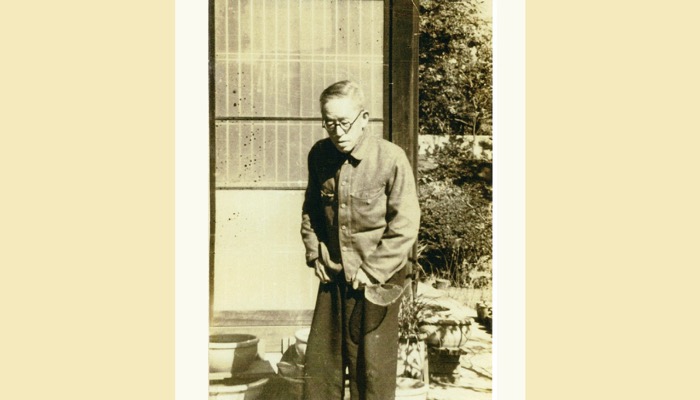From a Kyoto garden to scientific discoveries.
Since the 17th century, medaka fish have been bred for their beautiful colors. Shortly after the 1900 re-discovery of Mendel’s laws of inheritance, medaka began to be used for genetic studies. Recessive inheritance of the orange-red (b) and white (r) variants, female-limited appearance of the white phenotype, and an additional allele on the b locus causing variegation (B′) were reported by three professors publishing in Japanese [1–3]. The first medaka article written in English was published in 1921 by Tatsuo Aida (1872-1957). One hundred years after publication of this landmark article in GENETICS, we reflect on Aida’s work and legacy.
When he was four years old, Aida’s samurai father cut off a thief’s arm, which remained a traumatic memory throughout his life. He liked playing in a neighboring farm in Kyoto, where he nursed his interests in zoology. He studied development and phylogeny of Chaetognaths at Tokyo Imperial University, but, due to a conflict with his supervisor, left there before getting his PhD and became a teacher in a high school in Kumamoto, where Soseki Natsume, a Japanese novelist, worked as a colleague. Besides his daily duties, he studied Larvaceans for five years and reported four new species [4].
When his father died, Aida returned to Kyoto in 1903. Teaching at Kyoto Higher Technical School, he started genetic studies in 1913 in his own home. He chose medaka because the fish could be bred en masse in small flowerpots, sex could be determined from appearance, and color variants were available from local fanciers. Studies of plants or mice would have required much larger spaces. Supported by Genzo Shimazu (a president of Shimadzu Corporation, where Aida was a counselor for zoological specimens), he constructed a breeding farm at his home consisting of 40 concrete tanks of 60 x 60 x 45 cm and 200 Yuzen dyeing pots of 30 cm diameter x 10 cm depth. Recording weather and air/water temperatures every day, he continued his research until 1954 at an age of 83.
His results were published as three articles in GENETICS. In the first [5], Aida performed a total of 22 crosses of two generations, recorded body color of 17,281 fish (5,304 of which were also analyzed for sex) and demonstrated:
- Mendelian-recessive and independent inheritance of the b and r phenotypes,
- dominant hierarchy of three alleles on the b locus,
- female-limited (i.e., sex-linked) inheritance of the r phenotype, and
- recombination between the X and Y chromosome.
These findings, particularly the fourth, impressed the editor, William Castle, who expressly added a footnote and even paid color charges for Aida’s illustrations (Fig. 1). Richard Goldschmidt, also being impressed by this article, visited Aida’s breeding farm during his stay in Japan in 1924.

Figure 1: Handpainted illustrations from Aida 1921, showing orange-red, white variegated with black, white, brown-black (wild form), orange-red variegated with black, and bIue-black medaka varieties.
In the second article [6], Aida analyzed nine fish (out of 13,065) with exceptional color and sex phenotypes and found that their descendants (16,385 in total) were variously unbalanced in sex ratios. He discussed this phenomenon from a viewpoint of non-disjunction of the sex chromosomes and suggested physiological differences between the X and Y chromosomes cause “one-sided crossing over”; i.e., dominant (functional) alleles tend to be lost from the Y chromosome rather than gained from the X chromosome. He also described new dwarf mutants, fused and wavy, analyzing their 8,930 inter- or back-crossed siblings.
In the third article, color and sex of 14,958 fish were analyzed [7], and Aida reconsidered the second article from a viewpoint of sex reversal, proposing a new hypothesis for sex determination, i.e., the total sum of “sexual exciters” on the X and Y chromosomes determines sex, and the potency of exciters fluctuates at various degrees (either positively or negatively) depending on inner (e.g., recombination or mutation) or outer (e.g., temperature) conditions. At that period, various opinions on sex determinants existed among researchers (e.g., Goldschmidt, Kosswig, Winge, and Bridges). It should be noted that Aida’s hypothesis was intrinsically correct and could explain sex-determining phenomena in other animals.
These monumental achievements by Aida clearly showed the usefulness and effectiveness of medaka as a research model. Having a non-academic position, however, Aida had no students or colleagues to take over his studies or fish stocks. It was miraculous that in 1954 when Aida stopped his research due to illness, an undergraduate student at Okayama University, Tetsuro Takeuchi (1932-), visited him and became Aida’s first and last student. Aida proposed Takeuchi study a new body-color mutant, color interfere (ci), which was confusing him with its “interfering” phenotype. Aida died in 1957 and Takeuchi was awarded a PhD degree in 1968 for studying ci. Teaching at a college, Takeuchi constructed a breeding farm at his home and kept the ci and other Aida’s strains until now. Without his devoted efforts for decades, Aida’s fish, including the rare recombinants and new mutants, would not have survived to the present.
After a long dormancy, the medaka color and sex genetics research that Aida initiated a century ago came into bloom. The color genes (b and ci, but still not r) and the male determinant (the Dmy gene) were unveiled [8–10]. An inbred strain derived from Aida’s collection (Hd-rR) enabled quick sequencing of the whole genome [11]. Knowledge of the molecular bases of color perception and mating preference is accumulating [12, 13]. Takeuchi, on reaching the age of 89, decided to close his farm in this memorial year and deposited all strains he had kept for 67 years to the Medaka bioresource project (NBRP Medaka). He also gifted the authors a pair of Aida’s Yuzen dyeing pots.(Figure 2). The NBRP Medaka was initiated in 2002 and has continued for 20 years. Now over 800 strains and 895000 BAC/Fosmid/cDNA clones and other information are available (https://shigen.nig.ac.jp/medaka/top/top.jsp) [14]. This blooming time may not last long in Japan [15], but the number of medaka researchers has markedly increased worldwide in the last 100 years. We imagine even more medaka researchers will appreciate Aida’s work next century, on the 200th anniversary, hopefully alongside important works from today’s era of medaka research.

Figure 2. Medaka strains and Yuzen dyeing pots, photos courtesy of Kiyoshi Naruse
You can learn more about Aida’s life and work in an account from Dr. Takeuchi here. Note that the site can be translated into multiple languages using the Google Translate menu on the page.





Figure 3. Photos of Tatsuo Aida and his medaka nursery, courtesy of Tetsuro Takeuchi and Kiyoshi Naruse.
About the authors:

Shoji Fukamachi, Professor, Department of Chemical and Biological Sciences, Japan Women’s University.

Kiyoshi Naruse, Specially appointed Professor, National Institute for Basic Biology. Head of National BioResource Project Medaka, Japan.
REFERENCES
- Ishikawa, C., 1913 Dobutsugaku Kogi [Zoological Lectures] Vol.1: pp 372.
- Toyama, K., 1916 Ichinino Mendel-Seishitsu ni tsuite. [On some Mendelian characters.] Nippon Ikushugakkai Hokoku [Report of Japanese Breeding Society] 1: 1-9.
- Ishiwara, M., 1917 On the inheritance of body-color in Oryzias latipes. Mitteilungen aus der medizinischen Fakultät Kyushu 4: 43-51.
- Aida, T., 1907 Appendicularia of Japanese waters. The journal of the College of Science, Imperial University of Tokyo, Japan 23: 1-25.
- Aida, T., 1921 On the inheritance of color in a fresh-water fish Aplocheilus latipes Temmick and Schlegel, with special reference to sex-linked inheritance. Genetics 6: 554-573.
- Aida, T., 1930 Further genetical studies of Aplocheilus latipes. Genetics 15: 1-16.
- Aida, T., 1936 Sex reversal in Aplocheilus latipes and a new explanation of sex differentiation. Genetics 21: 136-153.
- Fukamachi, S., Shimada, A., & Shima, A., 2001 Mutations in the gene encoding B, a novel transporter protein, reduce melanin content in medaka. Nature Genetics 28: 381-385.
- Matsuda, M., Nagahama, Y., Shinomiya, A., Sato, T., Matsuda, C., et al., 2002 DMY is a Y-specific DM-domain gene required for male development in the medaka fish. Nature 417: 559-563.
- Fukamachi, S., Sugimoto, M., Mitani, H., & Shima, A., 2004 Somatolactin selectively regulates proliferation and morphogenesis of neural-crest derived pigment cells in medaka. Proceedings of the National Academy of Sciences of the United States of America 101: 10661-10666.
- Kasahara, M., Naruse, K., Sasaki, S., Nakatani, Y., Qu, W., et al., 2007 The medaka draft genome and insights into vertebrate genome evolution. Nature 447: 714-719.
- Okuyama, T., Yokoi, S., Abe, H., Isoe, Y., Suehiro, Y., et al., 2014 A neural mechanism underlying mating preferences for familiar individuals in medaka fish. Science 343: 91-94.
- Shimmura, T., Nakayama, T., Shinomiya, A., Fukamachi, S., Yasugi, M., et al., 2017 Dynamic plasticity in phototransduction regulates seasonal changes in color perception. Nature Communications 8: 412.
- Sasado, T., Tanaka, M., Kobayashi, K., Sato, T., Sakaizumi, M. and Naruse, K. 2010 The National BioResource Project Medaka (NBRP Medaka), An integrated bioresource for biological and biomedical sciences. Experimental Animals 59, 13-23.
- Fuyuno, I., 2017 What price will science pay for austerity? Nature 543: S10-S15.













